Spinal diseases become younger each year.One of the most common osteochondrication residues, which was only recently considered an exclusively age -related disease.If it affects the cervical spine, there may be quite severe pain in the throat, hands and head, significantly reducing the quality of life.This is often accompanied by various other disorders and, if left untreated, leads to the formation of intervertebral gardens, large tumors of which require surgery.Therefore, it is important to diagnose cervical osteochondria as soon as possible and start treatment according to the condition.

Symptoms of cervical spine osteochondry
The cervical spine osteochondria is a disease in which degenerative changes occur on the intervertebral discs.Initially, the discs, which are cartilage that contain jelly -like contents, become dehydrated.This is more commonly the result of a sedentary lifestyle, prolonged on the computer, poor posture, throat injury and many other factors.
This leads to a decrease in the strength of collagen fibers that form the fibrosus ring disc.As a result, its thickness is gradually reduced, which becomes the main reason for the development of symptoms that characterize cervical osteochondria:
- Pain in the throat of a variety of degree of intensity.
- Headaches, dizziness, loss of consciousness caused by a violation of cervical vertebral arteries passing directly through the vertebrae, namely the development of the vertebral artery syndrome.
- fluctuations in blood pressure levels.
- The root syndrome, caused by the spine root sting, accompanied by the radiation of pain from the throat to hands, to the hands and fingers, on the head, shoulders, aesthetic disorders in these areas, the appearance of the goats.
- Reduce the range of motion of the throat, appearance or intensification of pain in performing certain movements.
- Increased fatigue, reduced efficiency.
- Boats, reduced visual acidity, development of ENT pathologies that are difficult to deal with.
There are 7 vertebrae in the cervical spine.Most of the time, osteochondria affects the discs between the 5th and 6th, as well as the 6th and 7th vertebra.
In such situations, you should contact a neurologist who prescribes a magnetic resonance imaging.The results of this examination make it precisely determined by osteochondicity in any, even the initial stage of development and treatment option.
Stages of growth
Generally, there are 4 stages of osteochondal development:
- Grade 1 - Pathological changes as soon as they begin to appear on the intervertebral disc, so the symptoms are mild and are observed only from time to time.In such conditions, treatment will be as effective as possible and simple.
- 2nd degree - changes in discs become more intense, leading to the appearance of pain pain, which occurs and intensifies when performing head movements.
- Grade 3 - Pain becomes almost stable and can be complicated by the development of spine syndrome, as well as by the formation of protrusion and intervertebral hernia.
- 4th grade - the disc is destroyed so that the likelihood of movement in the part of the spine is almost completely excluded.In this case there is severe pain, often the radical syndrome develops and one or both vertebral arteries are stingy, leading to characteristic symptoms.
Treatment of osteochondry
Thus, cervical cervical treatment tactics depend on the severity of degenerative changes in intervertebral discs, patient age and individual characteristics.Therefore, it always develops separately for each patient, but always aims to solve the following problems:
- The elimination of unpleasant symptoms that exacerbate the patient's quality of life.
- Improving the quality of blood circulation in the throat.
- improvement of metabolic processes in the affected area;
- eliminating the causes of degenerative duplicate changes in intervertebral discs.
- Reduce the risk of developing osteochondrialization complications, namely protrusions, garden intervertebrals, vertebrae, etc.
In general, at every stage of disease development, the use of different therapeutic measures is indicated.If in the first stage it will be enough to adjust your lifestyle and participate in exercise therapy, then the 2nd stage will require a more extensive effect, in addition, including taking many medicines, conducting manual treatment sessions, using orthopedic devices, etc.etc.
But patients should understand that it is impossible to achieve a reverse reflux of degenerative transport changes that have already occurred, especially if stage 2 or more osteochondria is diagnosed.In such conditions, the treatment will be aimed at improving the patient's well -being and cease the further development of the disease.Sometimes it is possible to fully correct the condition only in the 1st stage of osteochondrialism, but at this stage of development the pathology is very rarely diagnosed, as patients perceive little discomfort in the throat only as a sign of fatigue and do not consult a physician.
In more severe cases, the treatment of cervical spine osteochondal will be even more complicated and long.In any case, it is performed under the supervision of a neurologist with periodic monitoring tests and treatment adaptation according to changes in the patient's well -being.
Correction of lifestyle
All patients diagnosed with cervical osteochondria are advised to make some changes in their lifestyle.In any case, these recommendations vary according to the characteristics of the professional activity of the individual and many others.
The overwhelming majority is recommended to increase their level of physical activity and take a break from work at least every hour to warm up if it is a meeting.In cases where the patient is actively involved in sports, it is recommended to reduce the load on the cervical spine.This will prove to be abandoned running, jumping sports, weight lifting and fighting.
People who are overweight are also recommended to take steps to reduce it as well as to adjust their diet.When osteochondria has already happened, it is important that diet responds to the daily needs of the body as much as possible.Therefore, it is worth giving up fast food and semi-finished products and bringing your diet closer to reason.This means that it is worth creating a menu so that half of the diet consists of vegetables and fruits, and also contains a sufficient amount of protein.
Cervical osteochondal drug treatment
Pharmaceutical therapy is mainly aimed at eliminating the unpleasant symptoms of cervical spine.As a rule, it is complicated and includes the use of drugs by different groups, each solving specific problems.Therefore, it also develops separately for each patient.
NSAID
Non -steroidal anti -inflammatory drugs or NSAIDs are a wide group of drugs that have not only anti -inflammatory but also analgesic properties.Available in various dosage forms, including tablets, capsules, ointments, gels and creams, as well as solutions for intramuscular administration.NSAIDs should only be used at request, that is, when serious neck pain occurs.
For severe pain, NSAIDs can be administered intramuscularly.
The disadvantage of oral drugs by the NSAID group is their irritating effect on the mucous membrane of the stomach and duodenum.This can cause worsening the course of these organs, especially gastritis and digestive ulcers.To reduce the risks, proton pump inhibitors are prescribed in conjunction with them.
There are medicines that have a milder effect on the gastrointestinal tract, which have been widely prescribed to relieve pain and inflammation in osteochondria.Also, more advanced drugs have already been developed, characterized by a selective effect, which are also often prescribed for osteochondria but are more expensive and not available to all patients.
Corticosteroids and injections (exclusions)
Corticosteroids are hormonal drugs prescribed in patients with severe inflammatory processes.They can cause a series of undesirable consequences with long -term use, so they are prescribed in short lessons in the most difficult cases.As a rule, the use of infusion solutions is indicated, as this drugs are much easier to tolerate the body and are less likely to cause side effects.
Corticosteroids are often used in combination with locally anesthetics when executing blockages, that is, to quickly relieve very severe pain by inserting the mixture at special points near the spinal nerve.The process requires certain skills and skill and therefore can only be executed in medical institutions by specially trained medical workers.Otherwise, the likelihood of developing undesirable consequences and complications is very high.
It is recommended to make exclusions no more than 4 times a year.
Muscle
Muscle relaxants are a group of drugs used to eliminate reflexive muscle spasms caused by an acute inflammatory process.This is often the case with cervical osteochondria and causes severe neck pain, which further aggravates the condition.
Vitamins
Since osteochondria creates significant conditions for compression of spine roots, it is often indicated to obtain vitamins complexes that contain mainly B vitamins. They are directly involved in the transmission of nerve impulses, which are particularly important in the development of radical.
Protection
Horrhoproteters are medicines around which many controversy flashing.They are based on substances used by the body to restore the damaged cartilage tissue, which determines the indications for their use in cervical osteochondria.But at the same time, there is no convincing evidence of their effectiveness in advanced forms of the disease.In the early stages of osteochondry, they actually have a positive effect on the state of the intervertebral discs, which leads to improved the patient's well -being.And in later stages, they can only help suspend the further evolution of degenerative changes in the intervertebral discs.
Chondrop Protectors are produced in the form of powders for the preparation of solutions, capsules, products for topical use, as well as solutions for intramuscular administration.The biggest positive result was observed by the latter.
Local products
These are precisely the drugs, available in the form of a gel, cream or ointment, which patients begin to use frequently when signs of cervical osteochondrication occur.They have different results, including anti -inflammatory, analgesic, heating or, vice versa, cooling and local irritants.
Often these products contain NSAIDs to help reduce pain, but they are mainly effective in the early stages of osteochondry.Also, the ingredients of such drugs can be menthol, an extract with hot pepper, snake or bee poison.
Local irritants act at the beginning of the irritation of the nerve endings of the skin, due to which there is a decrease in the severity of the pain and the increased blood flow to the area of the application.But such treatments are effective only in the early stages of the development of cervical osteochondrication.
Preparations to improve microcirculation
The drugs in this group are used to improve the quality of blood circulation, which is particularly essential for the spinal artery syndrome.Some medicines have a vasodilator effect, which improves brain diet and helps to eliminate tinnitus, headaches and dizziness.But without efficiently eliminating the factor exerting pressure on the spine, this treatment will only provide temporary results.
Exercise treatment
Natural treatment is the basis for the treatment of cervical spine osteochondicism.Today, there are many different privately owned and generally accepted methods of treatment for cervical osteochondria, but patients must understand that there are no universal exercises.A set of exercises must be selected by an individual basis, taking into account not only the stage of development of degenerative metaphorical changes, but also the age of the patient, the nature of existing consequent diseases, the presence of radical syndrome or the compression of the vertebral arteries.Therefore, different exercises may be reported for the same patients with about the same changes to the intervertebral discs.
In general, physical therapy has the following goals:
- Enhance the muscles of the neck and upper shoulder zone.
- Activation of blood circulation in the affected area, which will help restore intervertebral disc fibers.
- Normalization of muscle tone.
It is necessary to do exercise treatment every day.Initially, it is best to attend special teams or work with an exercise therapy instructor separately.This will allow you to make 100% of the technique of performing any proposed exercise so that its application offers the maximum benefit.The expert will help you choose the optimum load and develop a program to increase it, taking into account the level of physical development of the patient.
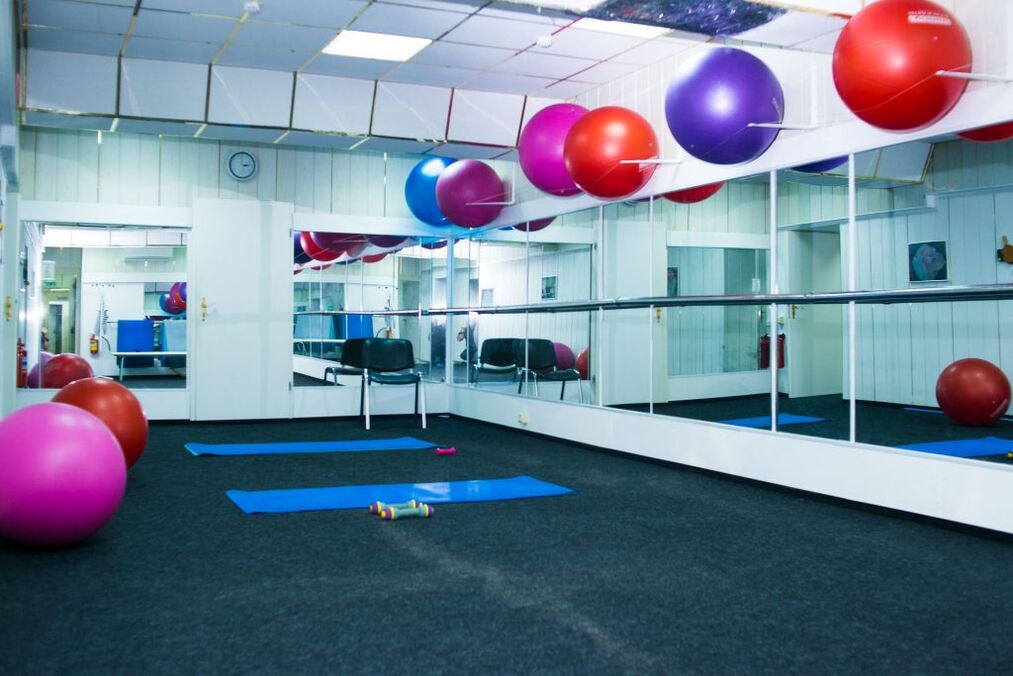
In the future, patients can be treated independently at home.At the same time, it is important to approach this with full responsibility, to perform the exercises slowly, without hurry and in comfortable conditions.But if the pain occurs at any time during exercise, you should immediately stop the exercise that caused its appearance and consult your doctor to determine the causes and correct the exercise treatment program for cervical osteochondria.
When you do exercise treatment, it is forbidden to make sudden, strong movements, rotate your head or perform pain exercises.In such cases, there is a high risk of worsening existing changes in the discs instead of gaining the expected benefit.
Swimming has a very positive effect on the state of the spine.This is precisely the kind of sport that does not include stress on the discs, but actively involves the muscles of the back and throat.As a result, the muscle corset is effectively enhanced, acting as natural support for the spine.Therefore, if possible, patients are advised to visit the pool 2-3 times a week.
Manual treatment for cervical osteochondria
Manual treatment is one of the most effective methods of cervical cervical treatment, as it allows you to affect not only muscles and soft tissues but also the spine itself.But it is very important to follow a responsible approach to choosing a chiropractor, since the wrong or very strong influence can lead to a deterioration in the patient's condition and even the development of complications.Such a specialist must not only have higher medical training and permission to exert manual treatment, but also have a good understanding of the characteristics of anatomy and osteochondry and have adequate experience.
Do not confuse manual treatment and therapeutic massage.The differences between these types of manual therapy are significant, as the therapeutic massage includes only soft tissues, and during manual treatment the doctor also works in the spine.
Thus, each manual treatment session begins by caressing, which allows you to prepare the skin for more active consequences.In the future, rubbish, fermentation and compression techniques are used, allowing you to activate blood flow to the collar, neck and upper back.Once the skin and muscles are sufficiently heated and the patient is relaxed, the doctor begins to perform mobilization and manipulation techniques.They imply the application of speeds with oscillating movements, pushes in the direction of the most intense restriction of movement, which leads to increased spine mobility and the elimination of operating blocks.
Thus, thanks to special manual treatment, it is possible:
- Normalize the location of the vertebrae, thereby eliminating increased pressure on the intervertebral discs and the creation of favorable conditions for their restoration.
- They eliminate the pain caused by the cervical osteochondria and its complications.
- Bring excessively loose muscles to normal tone and relax the spasmodic muscles.
- Increase throat mobility.
- They eliminate the pressure on the vertebral arteries and thus smooth the blood flow to the brain.
- Eliminate the compression of the roots of the spine and thus smooth out the conductivity of bioelectric impulses in those organs for which they are responsible, as well as the reduction of pain.
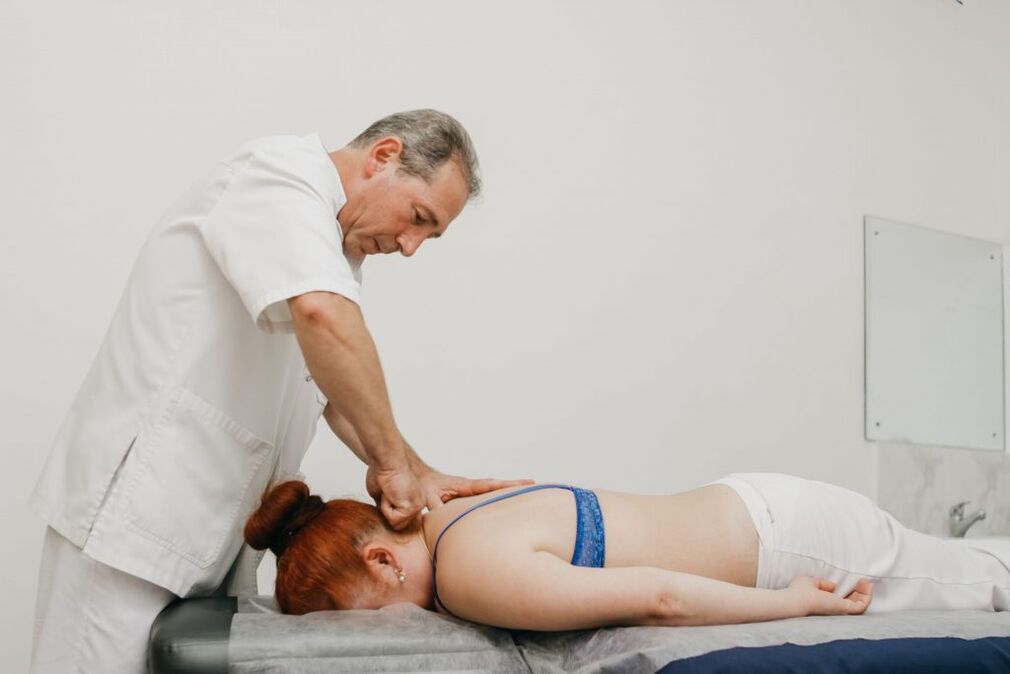
It is especially worth noting the author's manual treatment method.Includes the use of specialist, patent -patented impact techniques, which make it possible to achieve intense effect after the 1st session, not only on the side of the neck affected by the osteochondria and the whole body.As a result, not only the pain and other symptoms of the disease disappear, but the function of all organs improves and the immune system is enhanced.The second and subsequent sessions reinforce the positive result and unify it, which guarantees that if other medical recommendations are followed, the recession will last as long as possible.
Self-massage
To improve their well-being, patients can perform neck self-massage periodically to relieve the feeling of fatigue and reduce pain.To do this, sit in a comfortable position and try to relax the muscles of your throat.Then perform movements by stroking the palms, gradually moving to circular rubbing, recording the shoulder area.All movements are performed by the spine without sudden and strong pressure.In this case, you can use local anti -inflammatory drugs recommended by your doctor.
Physiotherapeutic therapy
Physiotherapy is indicated outside the acute inflammatory process.It allows you to consolidate the successful results of treatment and further improve the patient's condition.As a rule, a course of 10-15 procedures is provided, selected separately for each patient.Could be:
- Electrophoresis - includes the use of electricity to ensure a deeper penetration of indicated drugs.
- Magnetotherapy - helps activate blood circulation in the field of influence and stimulates the course of metabolic processes.In addition, magnetic therapy sessions have analgesic effect and help eliminate swelling.
- Laser treatment has an anti -inflammatory, vasodilator effect, which leads to a reduction in the severity of the pain.
- Ultrasound treatment is a method of physiotherapy based on the positive effect of ultrasonic waves on the body.They help reduce the sensitivity of nerve endings and also have an anti -inflammatory and analgesic effect.
- Distribution currents - processes lead to pain reduction, improve tissue nutrition, have a positive effect on muscles and help eliminate inflammation.
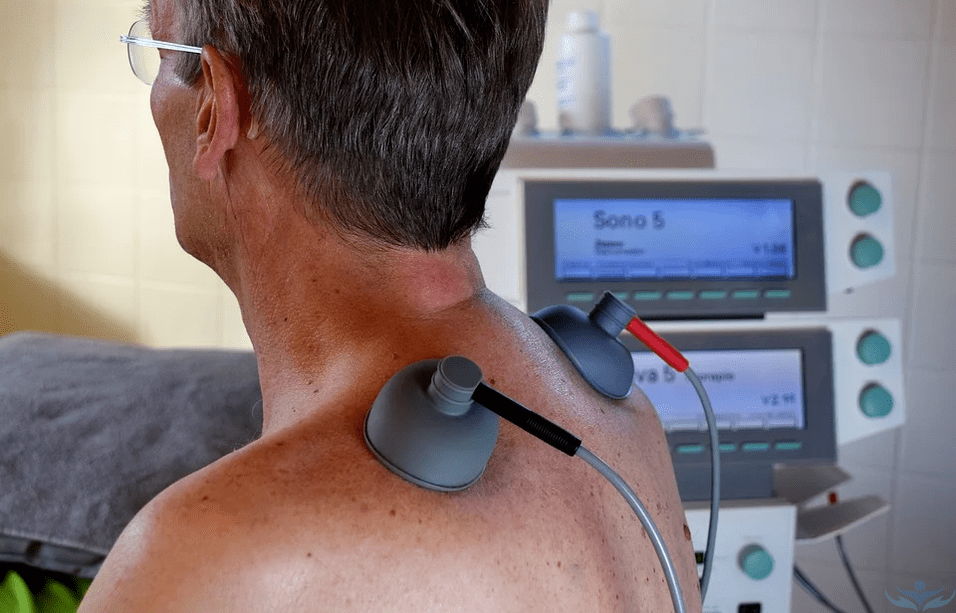
Traction
When the vertebrae meets due to the leveling of the intervertebral discs, adhesion therapy is indicated using Glisson loop.The essence of the method is to apply an accurate tensile load on the cervical spine using a special device that corrects the head and has a load on the opposite side.Such procedures help increase the distance between vertebrae, which leads to a reduction in pressure on the discs and creates favorable conditions for their recovery.But such a treatment can only be prescribed by a doctor.
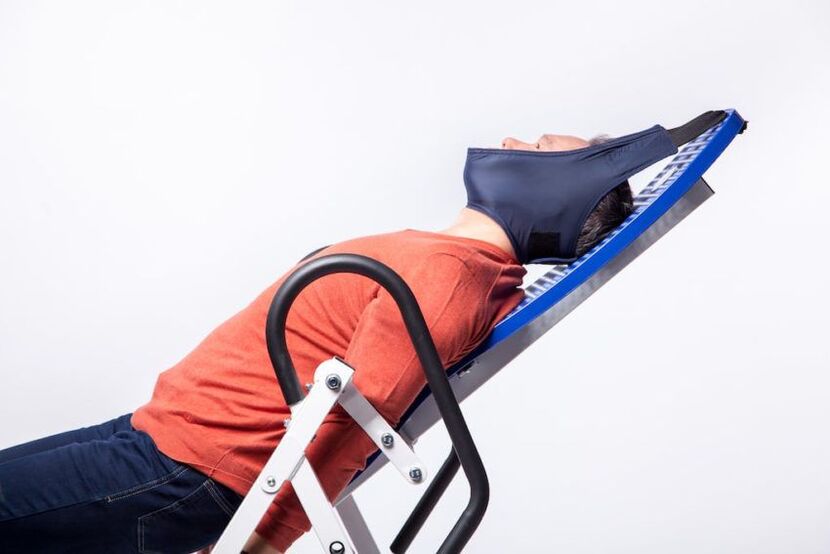
Needle
The iplicator is a simple, affordable medium of reflexology in the throat area.This could be a plate with spikes that need to be placed under the neck or a similar device, but in the form of a cylinder.Thanks to the tingling of the thorns, the skin receptors are irritated, which leads to a more active blood flow in the affected area.
Some patients report a decrease in throat pain after the use of the applicator, as well as increased efficiency, improve sleep quality and restoring throat mobility.But if you have skin lesions in the affected area or vascular diseases, you should not use a needle applicable.
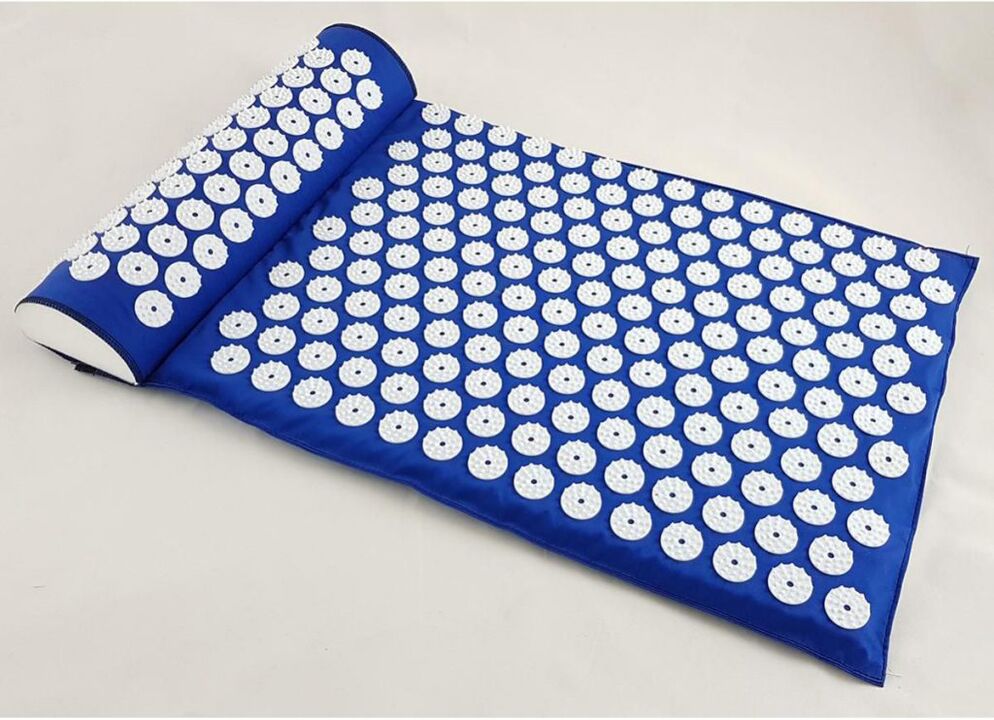
Orthopedic devices
In order to reduce the load on the cervical spine, it is recommended to change the mattress and pillow to orthopedics, as sleeping on an unpleasant pillow causes additional compression of the vertebral arteries and nerve trunks during sleep.Orthopedic products are free of this disadvantage and ensure that the spine is properly properly maintained along the length and thus reduce the rate of evolution of existing osteochondry.
But it is important to choose the right pillow and mattress so that they match the individual characteristics of the patient and contain the right filling.Thanks to them, it will also be possible to improve sleep quality and wake up in the morning happy and rest.
Also, some patients are recommended to wear a Shants collar.It is a removable orthopedic device that allows you to correct the neck and significantly reduce the load on the cervical spine, for example, when working on a computer or after being injured.The collar is placed before the expected load on the neck, but it must be removed during sleep and rest.They differ in design, height, the degree of fastening, so only the treating doctor can choose the best.
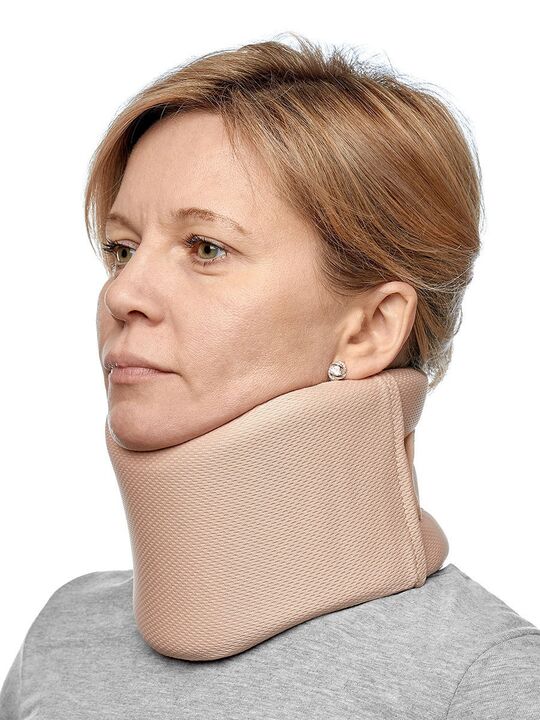
Thus, the treatment of cervical osteochondrication can be quite long and complex.You need to be prepared for this, because there is no other way to stop the development of changes in intervertebral discs, avoid the development of complications and the need for surgery.But in most cases, the condition of patients improves in the first weeks of treatment.At the same time, it is important not to self -treat, but to contact a neurologist, since only one expert will be able to determine the degree of osteochondry and to choose the most appropriate treatment for the disease for a particular patient.


















































